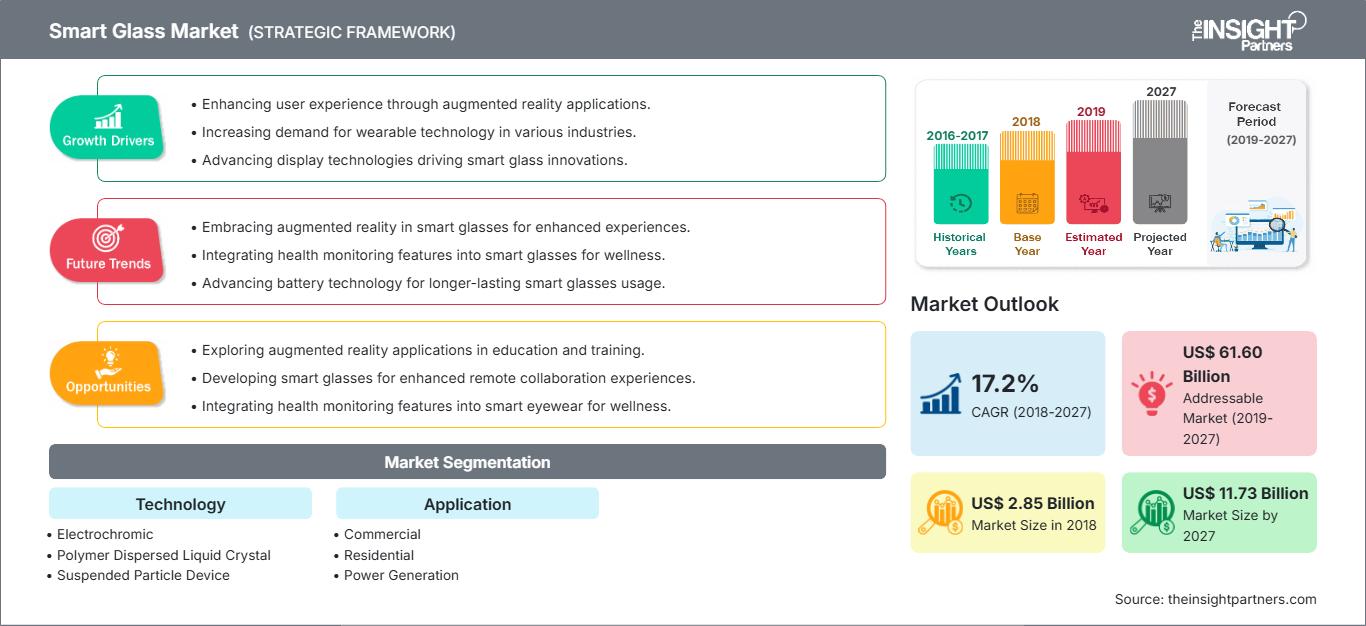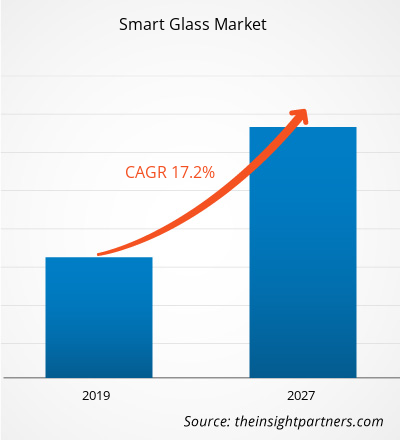[調査レポート] スマートグラス市場は2018年に28億5,000万米ドルと評価され、2027年には117億3,000万米ドルに達すると予測されています。また、2019年から2027年にかけて年平均成長率(CAGR)17.2%で成長すると見込まれています。
アナリストの視点:
スマートグラス市場は最近、目覚ましい成長と技術進歩を遂げており、この進化を牽引する主要分野がいくつかあります。拡張現実(AR)および仮想現実(VR)スマートグラスは大きな注目を集め、エンターテイメントやゲームだけでなく、自動車、データ分析、産業用スマート製造などの分野にも用途が広がっています。ARスマートグラスは、ユーザーの現実世界の環境にデジタル情報を重ね合わせることができるため、ますます人気が高まっています。この技術は、医療、建設、物流など、重要なデータへのハンズフリーアクセスや視覚的なガイダンスが不可欠なさまざまな業界で実用化されています。さらに、拡張現実(AR)および仮想現実(VR)スマートグラス市場は継続的に成長しており、メーカー各社はより没入感が高く直感的な体験の提供を競い合っています。スイッチングガラスやエレクトロクロミックガラス技術は、スマートグラス業界の変革において重要な役割を果たしてきました。ガラスの色合いや不透明度を調整することで、これらの革新的なソリューションは、建築用途においてプライバシー、エネルギー効率、そしてユーザーの快適性を向上させます。これらの進歩は特にスマートグラスおよびスマートウィンドウ市場に影響を与え、スマートグラス技術を建物に導入しようとしている商業・住宅セクターから注目を集めています。さらに、自動車用スマートグラス市場も大きく発展し、メーカー各社はスマートグラス技術を車両に統合しています。これにより、ヘッドアップディスプレイ(HUD)、拡張ナビゲーション、リアルタイム情報の提供が可能になり、運転体験が向上し、ドライバーの安全性と利便性が向上します。また、動的に変化するレンズや調整可能な視覚的拡張を求めるユーザーのニーズに応える、アクティブスマートグラスの需要も高まっています。これらのグラスは、調光レンズなどの機能を備えており、さまざまな照明条件やユーザーの好みに合わせて適応するアイウェアを提供します。産業用スマート製造において、スマートグラスは、作業員が工場の現場で機械とインタラクションを取り、情報にアクセスする方法に革命をもたらしました。人工知能(AI)グラスの統合により、リアルタイムのデータ分析が可能になり、生産性と効率性が向上し、エラーも削減されました。スマートグラス市場が進化を続けるにつれ、革新的なソリューションと優れた機能を提供する企業がますます増えています。トップクラスのスマートグラスブランドは、最先端技術とシームレスなユーザーエクスペリエンスを融合させた、最高のスマートグラスの提供を目指しています。
市場概要:
スマートグラスは、温度、電圧、光量の変化に応じて透過光量を変化させる建築用ガラスの一種です。これらのガラスは、住宅や商業ビルの内部間仕切り、窓、天窓などに広く使用されています。スマートアイウェアを使用すれば、手動と自動の両方の制御が可能です。スマートグラスの技術には、エレクトロクロミック、フォトクロミック、サーモクロミック、懸濁粒子、マイクロブラインド、ポリマー分散液晶デバイスなどがあります。スマートグラスは、建物の外壁に組み込むことで、気候に適応した建物の外壁を作り出します。スマートウィンドウなら、ブラインドやシェードなどの窓装飾は不要になるかもしれません。自然光をコントロールするだけでなく、スマートガラスは紫外線や赤外線を抑制し、広告を表示し、セキュリティ対策も提供します。
要件に合わせてレポートをカスタマイズ
レポートの一部、国レベルの分析、Excelデータパックなどを含め、スタートアップ&大学向けに特別オファーや割引もご利用いただけます(無償)
スマートガラス市場: 戦略的洞察

- このレポートの主要な市場動向を入手してください。この無料サンプルには、市場動向から見積もりや予測に至るまでのデータ分析が含まれます。
市場の牽引役:インフラプロジェクトへの投資増加がスマートグラス市場の成長を牽引
レポートの一部、国レベルの分析、Excelデータパックなどを含め、スタートアップ&大学向けに特別オファーや割引もご利用いただけます(無償)
スマートガラス市場: 戦略的洞察

- このレポートの主要な市場動向を入手してください。この無料サンプルには、市場動向から見積もりや予測に至るまでのデータ分析が含まれます。
インフラプロジェクトへの投資増加は、スマートグラス市場の成長を牽引する重要な要因として浮上しています。政府や民間セクターがインフラの近代化・更新に投資を増やすにつれ、スマートグラス技術は様々なプロジェクトで幅広く活用され、革新的なソリューションへの需要が急増しています。スマートグラスが大きな影響を与えている分野の一つが建設業界です。拡張現実(AR)スマートグラスは、計画段階と建設段階で活用され、リアルタイムのコラボレーションを促進し、建物の設計を視覚化し、関係者とのコミュニケーションを効率化します。これらのスマートグラスにより、現場作業員は物理的な設計図を必要とせずに3Dモデルや指示書などの重要な情報にアクセスできるため、生産性の向上とミスの削減につながります。さらに、スマートグラス技術をスマートビルディングに組み込むことが大きなトレンドとなっています。調光ガラス技術やエレクトロクロミックガラスは、エネルギー効率の高いビルに統合され、自然光を最適化し、室内温度を調節することで、エネルギー消費量の削減と居住者の快適性の向上につながっています。持続可能な建築手法が普及するにつれ、環境に優しくエネルギー効率の高いソリューションへの需要に支えられ、スマートガラスとスマートウィンドウ市場は大幅な成長を遂げています。自動車用スマートガラス市場も、インフラ投資の増加の恩恵を受けています。各国政府がスマートシティや交通システムの開発に注力する中、スマートグラスは先進的な自動車に不可欠な存在となっています。拡張現実(AR)ヘッドアップディスプレイ(HUD)や、切替ガラス技術を搭載したスマートウィンドウは、自動車の安全性、ナビゲーション、接続性を向上させるために採用されています。さらに、産業用スマート製造分野では、インフラプロジェクトの生産性と効率性を向上させるためにスマートグラスを活用しています。スマートグラスを装着した作業員は、リアルタイムデータにアクセスし、指示を受け取り、問題を即座にトラブルシューティングできるため、ダウンタイムを削減し、生産プロセスを最適化できます。インフラプロジェクトにスマート製造手法が取り入れられるにつれて、アクティブスマートグラスとAIを活用したソリューションの需要が高まると予想されます。インフラプロジェクトへの投資増加は、スマートグラス業界の市場成長を促進する触媒として機能します。生産性、安全性、持続可能性を向上させるためにスマートグラス技術を導入するプロジェクトが増えるにつれ、ARおよびVRスマートグラス、切替ガラス、その他のハイテクガラスソリューションの需要は引き続き増加するでしょう。インフラ開発とスマートグラス アプリケーションの融合により、メーカーに有利な機会が開かれ、スマートグラス市場のイノベーションが促進されます。
セグメント分析:
技術に基づいて、スマートグラス市場は次のようにセグメント化されています。
- エレクトロクロミック
- ポリマー分散液晶 (PDLC)
- 懸濁粒子デバイス (SPD)
- サーモクロミック
- フォトクロミック
- その他
懸濁粒子デバイス (SPD) セグメントは、2018 年に最大の市場シェアを占め、予測期間中に市場で最高の CAGR を記録すると予想されています。懸濁粒子デバイス (SPD) セグメントは、スマートグラス市場で最大のシェアを占める主要なプレーヤーとして浮上しています。この汎用性は、建築および自動車の両方のアプリケーションで大きな関心を集めています。建築分野では、SPDスマートガラスは、エネルギー効率を高め、室内温度を調節し、インタラクティブで視覚的に魅力的な環境を作り出す能力があるため、求められています。同様に、SPDスマートガラスは自動車業界ではサンルーフ、窓、サンバイザーに組み込まれており、ドライバーと乗客にカスタマイズ可能なシェーディングオプション、高度なグレア低減、および向上した快適性を提供しています。インフラ投資が増加し、スマートガラス技術の需要が促進されるにつれて、SPDセグメントはリーダーの地位を維持し、市場全体の成長に大きく貢献する態勢が整っています。
地域分析:
北米のスマートガラス市場は、2018年に10兆4,333億3,000万米ドルと評価され、2027年までに15兆3,861億1,000万米ドルに達すると予測されています。予測期間中は5.1%のCAGRで成長すると見込まれています。北米のスマートグラス市場は、力強い成長を遂げ、業界最大のシェアを獲得し、その優位性を確立しています。この地域が市場をリードする背景には、いくつかの重要な要素があります。北米はARおよびVR技術開発の最前線にあり、多くの企業やスタートアップ企業が、ヘルスケア、教育、エンターテインメントの分野でスマートグラスの革新的な応用を開拓してきました。こうした早期導入が、この地域のARおよびVRスマートグラス市場の成長を支える強固な基盤を築いています。さらに、北米のインフラ投資は、特に建築分野においてスマートグラス技術の需要を牽引しています。浮遊粒子デバイス(SPD)スマートグラスなどの調光ガラス技術の導入は、そのエネルギー効率と持続可能性の高さから、この地域で人気が高まっています。スマートビルディングや環境への取り組みが優先事項となるにつれ、北米市場では、光と温度を調節し、エネルギー消費を削減し、居住者の快適性を向上させるスマートウィンドウやガラスソリューションの需要が急増しています。自動車用スマートグラス市場も、この地域の先進的な自動車産業と車両へのスマートテクノロジーの統合に牽引され、北米で急成長を遂げています。サンルーフ、窓、ヘッドアップディスプレイ(HUD)などに、切り替え可能なガラスソリューションを含むスマートグラスを採用することで、運転体験が向上し、道路における安全性と利便性の向上に貢献しています。さらに、北米の大手スマートグラス技術企業とメーカーは、市場の優位性において重要な役割を果たしてきました。これらの企業は研究開発に多額の投資を行い、イノベーションを推進し、最先端のスマートグラス製品を生み出してきました。スマートインフラプロジェクトや持続可能な建築への取り組みに対する政府の支援も、北米のスマートグラス市場をさらに活性化させています。政策立案者は、エネルギー効率、環境保全、都市生活の向上といったスマートガラス技術の潜在的なメリットを認識しており、市場の成長を促す有利な規制やインセンティブにつながっています。
主要プレーヤー分析:
スマートガラス市場分析は、AGC, INC.、ArtRatio SL、Compagnie de Saint-Gobain SA、Corning Incorporated、GENTEX Corporation、日立化成株式会社、Pleotint LLC、Polytronix, Inc.、Research Frontiers Incorporated、Smartglass International Limitedなどのプレーヤーで構成されています。スマートガラスのプレーヤーの中で、GENTEX CorporationとCorning Incorporatedは、多様な製品ポートフォリオを提供していることから、トップ2のプレーヤーとなっています。
スマートガラス市場の地域別分析
予測期間を通じてスマートグラス市場に影響を与える地域的なトレンドと要因については、The Insight Partnersのアナリストが詳細に解説しています。このセクションでは、北米、ヨーロッパ、アジア太平洋、中東・アフリカ、中南米におけるスマートグラス市場のセグメントと地域についても解説しています。
スマートガラス市場レポートの範囲
| レポート属性 | 詳細 |
|---|---|
| の市場規模 2018 | US$ 2.85 Billion |
| 市場規模別 2027 | US$ 11.73 Billion |
| 世界的なCAGR (2018 - 2027) | 17.2% |
| 過去データ | 2016-2017 |
| 予測期間 | 2019-2027 |
| 対象セグメント |
By 技術
|
| 対象地域と国 | 北米
|
| 市場リーダーと主要企業の概要 |
|
スマートグラス市場のプレーヤー密度:ビジネスダイナミクスへの影響を理解する
スマートグラス市場は、消費者の嗜好の変化、技術の進歩、製品メリットへの認知度の高まりといった要因により、エンドユーザーの需要が高まり、急速に成長しています。需要の増加に伴い、企業は製品ラインナップの拡充、消費者ニーズへの対応、そして新たなトレンドの活用を進めており、これが市場の成長をさらに加速させています。

- 入手 スマートガラス市場 主要プレーヤーの概要
スマートガラス市場では、合併や買収などの無機的および有機的な戦略が企業に広く採用されています。最近の主要な市場動向をいくつか以下に示します。
- 2022年2月、Guardian Glassは、新築および既存の住宅の窓に関する新しい英国建築規制パートLを満たすように開発されたClimaGuard Neutral 1.0を発表しました。二重窓用の断熱コーティングガラスであるGuardian ClimaGuard Neutral 1.0は、Ug値が1.0 W/m2Kで、住宅窓用の他の1.0 U値ガラス製品よりもニュートラルな色と低い反射により、美観が向上しています。
- 2021年7月、建築用ガラスをワンストップで製造するViraconは、Halio, Inc.独自のエレクトロクロミック技術をViraconの断熱ガラスユニットに組み込んだ画期的な自動調光スマートガラスソリューションであるViracon PLUS Smart Glass powered by Halioを発表しました。 Halio を搭載した Viracon PLUS Smart Glass は、色合いのレベルを自動的に調整してエネルギー消費を削減し、自然光を最大限に活用することで、居住者の快適性を最適化します。
- 過去2年間の分析、基準年、CAGRによる予測(7年間)
- PEST分析とSWOT分析
- 市場規模価値/数量 - 世界、地域、国
- 業界と競争環境
- Excel データセット
最新レポート
関連レポート
お客様の声
購入理由
- 情報に基づいた意思決定
- 市場動向の理解
- 競合分析
- 顧客インサイト
- 市場予測
- リスク軽減
- 戦略計画
- 投資の正当性
- 新興市場の特定
- マーケティング戦略の強化
- 業務効率の向上
- 規制動向への対応




















 無料サンプルを入手 - スマートガラス市場
無料サンプルを入手 - スマートガラス市場